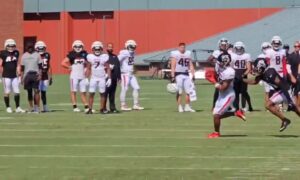The Pittsburgh Steelers are in unfamiliar territory in more ways than one. Perhaps the biggest and most unfamiliar challenge is the quarterback transition from Ben Roethlisberger following his 18-year career to first round pick Kenny Pickett. Quarterback transitions have proven to be a uniquely difficult task for a franchise, and an easy one to get wrong. The verdict is still out on how the Steelers chose to handle Pickett’s transition, and likely will be for a while. Current analyst and former Vice President of Football Operations for the Miami Dolphins and former New York Jets General Manager Mike Tannenbaum was asked about how the Steelers are handling the transition on Friday, and offered some insight on the topic.
“It’s always easy to say that hindsight is 20/20,” Tannenbaum said when asked if the Steelers’ quarterback transition could have been handled differently on 93.7 The Fan’s PM Team W/Poni & Mueller. “Certainly, Green Bay probably did it better than any of us in terms of like Aaron Rogers, Aaron Brooks, Mark Brunell, years and years and years of guys behind [Brett] Favre. It’s just hard to do because you got a guy like Ben, you got your window open and you’re just trying to put your resources where you can. If Kenny Pickett’s the guy then, then it’s gonna turn out really, really good. There’s just gonna be growing pains. Look, Josh Allen guys was far from perfect his rookie year, so we shouldn’t expect anything different from Kenny Pickett.”
As Tannenbaum stated, the hypothetical game is tricky. The fact is, Roethlisberger and the Steelers had a championship window for much of the 2010s with rosters that featured high-powered offenses with the likes of All-Pro receiver Antonio Brown and a top offensive line. During this era, the Steelers picked a defensive player in the first round every year from 2013-2019 to build a complementary defense to said high-powered offense. The team often had their first round picks in the 20s, where most of the top quarterback prospects were gone regardless.
The team did dabble in selecting mid-round quarterbacks, drafting Landry Jones, Josh Dobbs, and Mason Rudolph to back up Roethlisberger. However, none of those quarterbacks were regarded as the heir to Roethlisberger, which may have been for the best. Typically, veteran quarterbacks are not fond of the pressure that comes with a first round pick and presumed successor playing on the bench. Indeed, Roethlisberger is on record stating that the pressure of having the crowd chant “Kenny” while quarterback Mitchell Trubisky was playing was unfair.
Giving Pickett a year to develop behind Roethlisberger as the Packers did with Rodgers and Favre is ideal on paper. However, Pickett is a relatively older rookie at 24, which comes with the expectation of being pro-ready. The Steelers actual strategy of signing a veteran quarterback in Trubisky may have been for the best, as it is difficult to imagine Roethlisberger being benched under the same scenario.
Quarterback transitions are indeed difficult to navigate, and often come down to several key factors. Tannenbaum mentions Buffalo Bills’ quarterback Josh Allen, who looked less than impressive his rookie year. Even the biggest proponents of Allen admitted that he was a developmental player with elite measurable that needed time to mold, and they were right.
At the end of the day, only time will truly speak to the Steelers’ handling of the quarterback transition. This season will be telling, but likely not paint the full picture. It is easy to be excited for how Pickett’s career will unfold.








